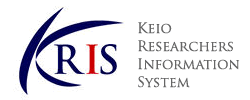-
Affiliation
-
Faculty of Pharmacy, Department of Pharmacy 衛生化学講座 ( Shiba-Kyoritsu )
-
Position
-
Professor

KEIO RESEARCHERS INFORMATION SYSTEM |
Details of a Researcher
このページはJavascriptを使用しています。すべての機能を使用するためにはJavascript を有効にする必要があります。
Tago, Megumi
|
|
|
2003年4月~2006年5月 米国留学 2006年6月 共立薬科大学薬学部生化学講座 助手 (2007年4月より助教) 2008年4月 慶應義塾大学薬学部生化学講座 助教 2009年4月 慶應義塾大学薬学部生化学講座 専任講師 2014年4月 慶應義塾大学薬学部衛生化学講座 准教授
共立薬科大学, 薬学部, 薬学科
University, Graduated
共立薬科大学大学院, 薬学研究科, 分子生物学、生化学
Graduate School, Completed, Doctoral course
Life Science / Pharmaceutical hygiene and biochemistry (Biological System Pharmaceutical Science)
Analysis of cytokine signaling pathway,
Lin X., Korai A., Nakazawa Y., Tago K., Funakoshi-Tago M.
Cellular Signalling 136 2025.12
ISSN 08986568
Nakazawa Y., Nishizawa F., Kawata S., Sugiyama Y., Nagai N., Yamamoto N., Funakoshi-Tago M.
Experimental Eye Research 258 2025.09
ISSN 00144835
Yasuda D., Toyoshima K., Kojima K., Ishida H., Kaitoh K., Imamura R., Kanamitsu K., Kojima H., Funakoshi-Tago M., Osawa M., Ohe T., Hirano T.
Chemmedchem 2025
ISSN 18607179
High ambient temperature may induce presbyopia via TRPV1 activation
Nakazawa Y., Kuno Y., Shimada H., Nagai N., Hiramatsu N., Takeda S., Yamamoto N., Funakoshi-Tago M., Sasaki H.
Medical Molecular Morphology 57 ( 4 ) 268 - 276 2024.12
ISSN 18601480
Takeda K., Ohta S., Nagao M., Kobayashi E., Tago K., Funakoshi-Tago M.
International Journal of Molecular Sciences 25 ( 7 ) 2024.04
ISSN 16616596
Tago, Megumi
福澤諭吉記念慶應義塾学事振興基金事業報告集 (福澤基金運営委員会) 2023
Tago, Megumi
科学研究費補助金研究成果報告書 2022
Tago, Megumi
学事振興資金研究成果実績報告書 (慶應義塾大学) 2021
Tago, Megumi
福澤諭吉記念慶應義塾学事振興基金事業報告集 (福澤基金運営委員会) 2021
Tago, Megumi
科学研究費補助金研究成果報告書 2020
炎症メディエーターと細胞 IL-1.
笠原 忠、多胡めぐみ.
炎症・再生医学事典(松島綱治、西脇徹編) (朝倉書店) 0 52-54 2009.04
Article, review, commentary, editorial, etc. (scientific journal), Joint Work
Anti-cataract effect of coffee intake on selenite-induced cataract in rat
TAGO Megumi
日本薬学会第136年会(横浜),
Poster presentation
Inhibitory effect of ParvifloronE on TNFa signaling pathway
TAGO Megumi
日本薬学会第136年会(横浜),
Poster presentation
Anti-inflammatory activity of Coffee extract
TAGO Megumi
日本薬学会第136年会(横浜),
Poster presentation
The role of DDX5 in JAK2 V617F mutant – induced transformation.
TAGO Megumi
日本薬学会第136年会(横浜),
Poster presentation
Mechanism of NPM-ALK positive cells apoptosis induced by crizotinib
TAGO Megumi
日本薬学会第136年会(横浜),
Poster presentation
Elucidation of pathogenesis of anaplastic large cell lymphoma via STAT3 target genes
基盤研究(C), Principal investigator
エリスロポエチン受容体結合分子を介した慢性骨髄増殖性腫瘍の発症機序の解明
MEXT,JSPS, Grant-in-Aid for Scientific Research, Grant-in-Aid for Scientific Research (C), Principal investigator
エリスロポエチン受容体のリン酸化を介した慢性骨髄増殖性腫瘍の発症機序の解明
MEXT,JSPS, Grant-in-Aid for Scientific Research, Grant-in-Aid for Scientific Research (C), Principal investigator
柿内三郎記念奨励研究賞第11回(2014年)
多胡 めぐみ, 2014.10, 日本生化学会, 「定量的リン酸化プロテオミクスによる慢性骨髄増殖性腫瘍の発症機構の解析」
Type of Award: Award from Japanese society, conference, symposium, etc.
第11回(2014年)柿内三郎記念奨励研究賞
多胡 めぐみ, 2014.10, 日本生化学会, 定量的リン酸化プロテオミクスによる慢性骨髄増殖性腫瘍の発症機構の解析
平成22年度関東支部奨励賞
Tago M., 2012.10, 日本薬学会, JAK2 変異体のシグナル伝達解析による真性赤血球増加症発症機構の解明.
FEBS Letters Young Group Leader Award 2011
Tago M., 2012.09, FEBS Letters, FEBS Letters Young Group Leader Award 2012.
2012 FEBS Letters Young Group Leader Award
TAGO MEGUMI, 2012.09, FEBS, Aurora kinase A critically contributes to the resistance to anti-cancer drug cisplatin in JAK2 V617F mutant-induced transformed cells
Type of Award: International academic award (Japan or overseas)
RESEARCH FOR BACHELOR'S THESIS 1
2025
PUBLIC HEALTH
2025
PHARMACEUTICAL-ENGLISH SEMINAR
2025
PHARMACEUTICAL SCIENCE OF BIOLOGY
2025
NUTRITION AND HEALTH SCIENCES
2025